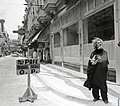José María López Lledín
José María López Lledín was an elegant vagabond known as El Caballero de París ("The Gentleman From Paris") who wandered the streets of Havana and was a well-known cult figure.
José María López Lledín | |
|---|---|
 El Caballero de Paris | |
| Born | December 20, 1899 |
| Died | July 11, 1985 (aged 85) |
| Nationality | Spanish |
| Other names | El Caballero de Paris |
| Occupation | Vagabond, Havana cult figure |
| Years active | Circa 1920–1985 |
| Known for | Walking the streets of Havana |
Biography
José María, the fourth of eleven children, was born at 11 a.m. on 30 December, 1899. Traveling in the German passenger ship S.S. Chemnitz, he arrived in Havana at twelve years of age on 12 December, 1913.[1] His mother was Josefa Lledín Mendes and his father was Manuel Lopez Rodriguez; the owners of a small vineyard, they produced and sold wine and Sherry. He was baptized in the Parish of Salvador de Negueira.[2]
According to his sister Inocencia, he worked as a tailor and in a bookshop. Later he worked as a waiter in the hotels Inglaterra, Telegrafo, Sevilla, Manhattan, Royal Palm and Saratoga.[2]
There are many stories as to why he lost his mental sanity but all of them converge on the fact that he was imprisoned in the Castillo del Príncipe in 1920 for a crime he did not commit.[3]
Aristocracy
Anybody that lived in Havana in the 1950s remembers El Caballero de París. Arquitecto Cheo Malanga writes about the one time that he saw el Caballero de París:
"El Caballero de París was a cult figure in Havana in the 40s and 50s. He was of medium height, disheveled hair with some gray hair and a beard. He always wore black, with a long coat of the same color, even during the summer. He used to carry a folder full of papers. He was a gentle and educated man who roamed the streets and traveled by bus all over the city, greeting people and discussing philosophy, religion and politics. He never asked for alms or said bad words, he only accepted money from people he knew or liked.
I remember an occasion during my childhood, while I was traveling in a car with my parents on Infanta street, that my mother shouted ..... "Look, look there is El Caballero de París!" When I turned my eyes I could only see a fleeting figure with long white hair and a black cloak that slouched away at a slow pace. That was my only encounter with the Parisian aristocracy of our homeland."[4]
Mental disorder
He was late in life diagnosed as suffering from paraphrenia, a late-onset mental disorder featuring such symptoms as delusions and hallucinations; it does not have any negative symptoms such as the deterioration of the intellect or of the personality.[5] He was a patient of Mazorra, the Psychiatric Hospital of Havana.[6]
References
- "S.S. Chemnitz Passenger Lists". Retrieved 4 November 2018.
- "El Caballero de París - Memoria de La Habana". Retrieved 4 November 2018.
- "El Caballero de París". Retrieved 4 November 2018.
- "El Caballero De Paris". Retrieved 24 December 2018.
- "Paraphrenia". Retrieved 4 November 2018.
- Luis Calzadilla Fierro, T. Silvia Rodríguez Pérez (1982). El caballero de París: Historia y psicopatología = The "gentleman from Paris": History and psychopathology. Revista del Hospital Psiquiátrico de La Habana 23 (2): 255–263.
Further reading
- Luis Calzadilla Fierro (2001). Yo soy el Caballero de París. Badajoz, España: Editorial Departamento de Publicaciones de la Diputación de Badajoz.
Gallery
 El Caballero de Paris in Havana, ca 1958.
El Caballero de Paris in Havana, ca 1958. Caballero de Paris_sitting on the Malecon sea wall. Havana, Cuba
Caballero de Paris_sitting on the Malecon sea wall. Havana, Cuba El Caballero de Paris on Calle San Rafael, Havana.
El Caballero de Paris on Calle San Rafael, Havana.